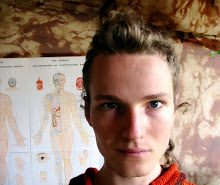
Our body is so precious. Modern society has objectified the body and turned it into merely a mechanism for carrying the brain around - the consciousness in the machine. There is growing awareness that we need to care for our bodies, however, mechanized treatment of the body remains dominant. It gets put on the diet of the moment and 'worked-out' in order to attain some idealized image or standard. When something goes wrong, it gets brought to a specialist to be 'fixed'. Very rarely is the space and time given to truly listen in and hear what our body needs. It needs a balanced, nutritious diet, it needs to be challenged in order to grow and remain well and able, and it needs to be given loving attention and supported in the amazing task of maintaining health and wellness. The evidence for lack of care of the living body in North America is staggering. The estimated annual price-tag on lower-back pain in the US (medical bills, lost work time, ect.) exceeds
$100 billion; cardiopulmonary disease is the #1 cause of death; and over 30% of the adult population is obese (
C.Ogden etal., 2006). The health crisis in North America has reached epidemic proportions.
Part of the issue is that we all need balanced physical activity. There is growing awareness of this and more and more people are looking to take better care of themselves. However the beneficial effects of diet and exercise can be stifled by being purely goal oriented in activities and abandoning our body to unconscious use - objectifying the body and attempting to impose idealized images and expectations. The opposite is also true. Whatever the activity - we can support ourselves, enhance our performance, and feel better by deepening in awareness of our body throughout all activities - allowing quiet moments of self-inquiry to permeate our days. This comes down to taking time to slow down, listen inwards, and learning to act sensitively in cooperation with your whole organism. We cannot 'fix' a living organism - life must be cultivated.
This might seem daunting in the face of the intense pace modern society asks us to maintain. However, softening and creating spacious moments regularly throughout the day can open us to deeper sensations and fuller expressions of support, vitality, balance, and healthy choice making. Like any new skill it takes practice, but the process brings many rewards, empowers us to take responsibility for our health, and enables us to move into more dynamic embodiment of our whole self. The emerging field of holistic health seeks to treat the whole person and help facilitate balance and wellness. Within this, Somatic Movement Therapies have developed to educate and provide individuals with the tools and physical resources they need to care for their bodies in our modern environment. Among these is the Center for Kinesthetic Education in New York which teaches a Dynamic Embodiment (DE-SMT) model for health, wellbeing, and an increased range of functional - and expressive - capacity.
Here is a gift you can give yourself - before getting out of bed, at work, waiting in line, or whenever you think of it. With a little practice it will quickly become a resource available to you at all times. Take some extra care at least the first couple times you do this to really get to know the sensations. If you listen in, an easy rhythm will emerge.
Using this movement regularly will have beneficial affects up through the knees and lower back and increase overall foot health: strength, mobility, and sensitivity for better efficiency in standing, walking, and running. It will relieve strain on the heart by acting as a pump for venous blood-flow, increases lymphatic flow up the legs for immune function and waste removal, and provide access to physical sensations of support and grounding
Mobilizing and Releasing the Feeta. Draw your toes towards your heels as if you were making fists with your feet - firmly yet without clenching - and release the whole of both feet into the ground. Repeat slowly 3-5 times. Notice any tendency to rush or strain. Notice your breath as you do this.
b. Allow the balls of the feet to become heavier and heavier until they start to push your heels away from the ground firmly - the toes are soft, heavy, and long. Slowly allow your heels to sink into the ground. Repeat 3-5 times. Notice if there seems like there is excess tension in your upper legs, groin, and hips - allow them to be soft and heavy.
c. Combine a & b: making 'fists' with both feet, releasing feet into ground, pressing balls of feet into ground to lift heels, lower heels into ground - relax feet into support of ground. Repeat 3-5 times in a gentle, slow rhythm and find a comfortable way to coordinate these movements with the breath.
In finishing, take a few moments to feel you feet heavy on the ground. Feel the solidness under them. Notice the the support of the ground pushing up on your bones and flowing up through your whole body. Use your breath to draw this support up from the earth. Experiment with pushing your whole feet into the ground a couple times and notice what happens to your head. If possible take a little walk and feel how how the support of the earth transfers all the way to your head.
Doing this regularly will benefit anyone - especially sedentary workers, those who run and walk for health, and anyone suffering from swollen or puffy legs, varicose veins, sore feet, or difficulty in feeling grounded. For added learning - do one foot, take a little walk to feel the difference between the legs, do the other, walk again, and then do both feet together.
Stay tune here for further articles on cultivating awareness and wellness within the body.







